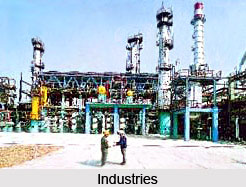 Industry: Bihar has a number of major public sector projects like the Oil refinery of Indian Oil Corporation and economy manufacturing plant of Hindustan Fertilizer Corporation Ltd (HPCL) at Barauni, Pyrites, Phosphates and Chemicals Ltd (PPCL) at Amjhor; Cotton spinning mills at Siwan, Pandaul, Bhagalpur, Mokamah and Gaya; 13 sugar mills in private sector and 15 in public section located in South and North Bihar. In addition distilleries at Gopalganj, West Champaran, Bhagalpur and Riga, finish leather industry in West Champaran, Muzaffarpur and Barauni; Jute mills at Katihar and Samastipur; Medicine manufacturing unit at Hajipur; Food processing units and Vanaspati manufacturing units at Aurangabad and Patna; Kalyanpur Cement Ltd at Banjari are some of the notable industries in Bihar. Bihar has tremendous resources and their utilization in the interest of its growing population has to be the supreme responsibility of both the economy and the national planners.
Industry: Bihar has a number of major public sector projects like the Oil refinery of Indian Oil Corporation and economy manufacturing plant of Hindustan Fertilizer Corporation Ltd (HPCL) at Barauni, Pyrites, Phosphates and Chemicals Ltd (PPCL) at Amjhor; Cotton spinning mills at Siwan, Pandaul, Bhagalpur, Mokamah and Gaya; 13 sugar mills in private sector and 15 in public section located in South and North Bihar. In addition distilleries at Gopalganj, West Champaran, Bhagalpur and Riga, finish leather industry in West Champaran, Muzaffarpur and Barauni; Jute mills at Katihar and Samastipur; Medicine manufacturing unit at Hajipur; Food processing units and Vanaspati manufacturing units at Aurangabad and Patna; Kalyanpur Cement Ltd at Banjari are some of the notable industries in Bihar. Bihar has tremendous resources and their utilization in the interest of its growing population has to be the supreme responsibility of both the economy and the national planners.
Agriculture: The principal agricultural crops are rice, paddy, wheat, jute, maize and oil seeds. Cauliflower, cabbage, tomato, radish, carrot, beat etc. are some of the vegetables grown in the state. Sugarcane, potato and barley are some of the non-cereal crops grown. The entire agricultural operations are divided into two crop seasons Kharif and Rabi. The Kharif season starts from the third week of May and lasts till the end of October followed by the Rabi season.
Within recent years some progress is noticeable. The only practical solution is that, first in increasing the productivity of the available land and second, in creating non-agricultural sources of employment through the development of industries. Agriculture is making progress in every direction. Farming is more scientific, the use of chemical manure is becoming more general, and the rotation of crops better understood. In the context of the predominantly rural character of the economy, national extension services has been developed to bring to the farmer the knowledge of better farming practices together with ready supply of means.
From the point of view of economic development, community development blocks provide opportunities for integrated rural development and there is provision in the block budget itself for (i) the improvement of agriculture, including provision for minor irrigation, soil conservation, improvement of village forests, animal husbandry and dairying (ii) development of co-operation (iii) village industries (iv) elementary education, especially provision of school buildings for local communities (v) rural water supply and the programme of minimum rural amenities, including construction of approach roads linking each village to the nearest road or railhead.






